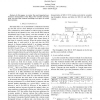Free Online Productivity Tools
i2Speak
i2Symbol
i2OCR
iTex2Img
iWeb2Print
iWeb2Shot
i2Type
iPdf2Split
iPdf2Merge
i2Bopomofo
i2Arabic
i2Style
i2Image
i2PDF
iLatex2Rtf
Sci2ools
PIMRC
2008
IEEE
2008
IEEE
Understanding the Performance of 802.11 Networks
Abstract—In this paper, we review the most important performance characteristics of the 802.11 DCF wireless networks, point out some false common knowledge, and report on recent improvements. I. 802.11 DCF BASICS The IEEE 802.11 DCF (Distributed Coordination Function) [1] uses the Carrier Sense Multiple Access/Collision Avoidance (CSMA/CA) access method: a station trying to transmit first checks if the channel is free, waits for the DIFS interval (Distributed Inter Frame Space), and then transmits if the medium is still free. The receiving station sends an ACK frame after the SIFS interval (Short Inter Frame Space) if the frame is correctly received. When the station senses the channel busy, it waits until it is free and after the DIFS interval, it chooses random backoff b, an integer uniformly distributed in the contention window [0, CW] (CWmin = 31 for 802.11b and CWmin = 15 for 802.11g) and counts down for b SLOT intervals before attempting to transmit. If another station transmi...
| Added | 01 Jun 2010 |
| Updated | 01 Jun 2010 |
| Type | Conference |
| Year | 2008 |
| Where | PIMRC |
| Authors | Andrzej Duda |
Comments (0)

